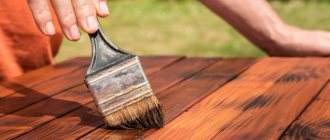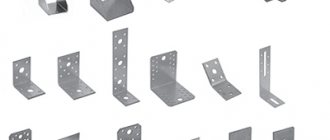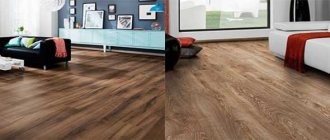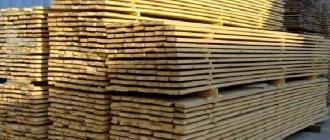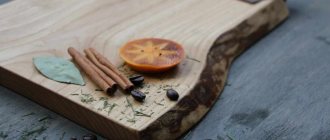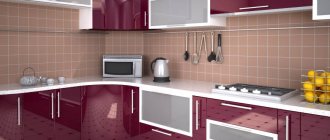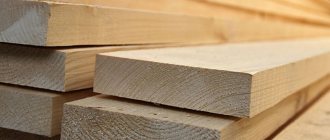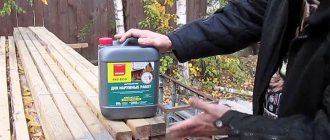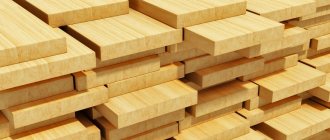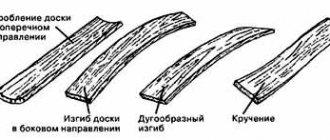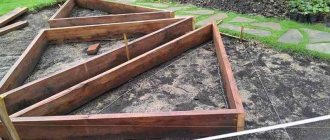Despite the abundance of various artificial materials intended for finishing floor coverings, natural wood has not lost its relevance. A floor or parquet made from first-class boards adds a unique touch to the atmosphere of a home, contributing to the unique harmony of man and nature. Many types of wood are used to construct wooden floors in buildings for various purposes, but the most common is pine, which combines acceptable durability, high aesthetic characteristics and a relatively low price. Naturally, the developer has a question about what kind of varnish to cover the pine floor in order to protect the soft pine wood from the effects of static loads and moisture that inevitably falls on it.
Benefits of wood floors
Wood is still used as a floor covering because it has a number of advantages over other coatings:
- natural plank flooring or parquet creates an atmosphere of coziness and comfort in residential premises;
- Externally, the wood is very beautiful, looks original in the photo and upon visual inspection, complementing any interior;
- some types of wood are very beneficial for the human body;
- the operational features of the material make it universal;
- the cost of the boardwalk is low, and it can also be partially repaired;
- wood can be processed using paints and various substances that improve its characteristics and protect it from the negative effects of various factors.
Next, we will talk about a type of wood such as pine, and how to cover a pine floor so that its operation will be a pleasure for every resident.
How to paint pine stair steps with varnish
If you are looking for something to cover a pine staircase in order to preserve the natural wood grain as much as possible, choose varnish or stain. The procedure for working with it differs quite a bit from coloring.
Preparing and covering stairs with stain + video
- Complete all preliminary work: protecting adjacent surfaces, cleaning, puttying, sealing, sanding.
- Using a paint brush, apply stain one step at a time. Leave for 2-3 minutes to absorb. Use a dry, lint-free cotton rag to thoroughly wipe off any excess substance, moving it only in a longitudinal direction.
- Treat all steps, balusters, and railings in the same way.
- If the color of the impregnation is uneven, repeat the treatment of the pine stairs. To ensure that the stain applies evenly, does not leave stains, and better emphasizes the texture of the wood, wet the surface with water before applying it. When working with stain, wear rubber gloves, as contact of hands with soiled rags is inevitable.
Before staining the entire staircase, experiment with the tone on a small, inconspicuous area. This will help you decide how to properly paint a pine staircase, achieving the desired decorative effect.
Finishing varnish on pine stairs (with video instructions)
The quality of the paintwork is influenced by how the final coat of paint was applied. Therefore, carefully follow the tips on how to paint pine staircase steps with varnish to get the perfect finish. The procedure for applying the finishing layer is as follows:
- Leave the staircase for 1 hour to dry completely, then proceed to apply varnish.
The interior staircase treated with stain and varnish looks so impressive
- If you do not want to make the wood darker, use wax impregnation or mastic instead of stain. After it dries, use a primer for better adhesion of the wax and varnish.
If you do not want to make the wood darker, coat it with varnish without stain
- Apply the first coat of varnish with a brush in a longitudinal direction. When working with varnish, it is not recommended to use a roller; it can leave microbubbles on the surface.
- After the first layer has dried, apply the second.
Features of pine floors
Pine is a tree with unique wood properties. The wood is very durable with a density of 520 kilograms per cubic meter (an average value and depends on the conditions in which the tree grew). Pine wood from trees that grew in dry places and acquired the most durable and reliable structure is especially valued among builders.
The texture and shade of pine lumber depends on what part of the trunk it came from. Closer to the center, dark red colors are obtained, and the outer layer (sapwood) has a light shade and the younger the tree, the paler the color.
For all its strength, pine has low hardness compared to oak or beech lumber, and therefore when laying pine board flooring, it is worth considering the places where heavy furniture or household appliances will stand, since deformations (dents) will definitely occur there.
At the same time, both the advantage and disadvantage of pine wood is its high resin content. From a positive point of view, resin can be noted as an additional moisture-resistant layer, but this component of wood tends to separate on the surface of lumber, which leads to inevitable damage to the appearance of the floor covering. Naturally, black spots will spoil any photo, and during a visual inspection questions will arise about the quality of the floors.
Why do you need to treat pine stairs?
Solid pine is used in the construction and finishing of budget wooden houses. This wood is not as durable as oak, cedar or larch, but it is quite wear-resistant, more common, cheap and accessible. Pine is better than spruce because it has a denser texture and much fewer knots, which reduce the strength of the lumber. But in order for the structure to last longer, painting the pine wooden staircase will be a mandatory step. A paint or oil coating will help protect the wood, make its surface less soft and improve its decorative qualities.
Pine products are distinguished by a pleasant light golden or almost white color and a unique pattern. Depending on the method of processing the steps of a pine staircase, you can reveal the natural wood pattern or give the wood a completely different shade.
Pine has a pleasant light golden or almost white color
Oil impregnations
Such substances have been used for a long time and their effectiveness is confirmed by ancient estates of the 18th-19th centuries, in which the floors are in perfect condition to this day. At that time, they did not yet know about varnish for wooden floors, but drying oil, hemp or linseed oil were actively used.
The surface of the boards was additionally rubbed with wax, which made it possible not to maintain the coating, but to protect it from stress for a period of 10-12 years. Some might say that more than a dozen years have passed between the 18th century and our time. The fact is that the applied substances function for 10-12 years, and then they are simply cleaned off, the wooden floors are sanded, and the oil and wax treatment procedure is repeated. At the same time, grinding is an extremely important stage of work. It is worth noting that even in ordinary military barracks of that time, pine floors were used for at least 50-70 years without replacement.
Advantages of using oils when processing pine boards:
- the oil is more stable when used in rooms with poor heating and large temperature changes (for example, a country house);
- the oil penetrates deep into the structure of the board, thereby creating a moisture-protective layer that prevents warping of the wood;
- after processing the board, it can even be used outdoors and under intense exposure to moisture, which has been proven in practice when creating ships from pine boards;
- Unlike the composition of some paints and varnishes for pine floors, oil impregnations do not change the structure of the wood and preserve its naturalness. Therefore, pine boards can be used even in specialized institutions (hospitals, kindergartens).
Natural and synthetic oils presented on the modern building materials market are very good at processing wood and create reliable protection against the penetration of moisture and air through the coatings, but oil is not able to create surface protection against wear, so additional treatment of the boardwalk with wax is necessary. If we are talking about the floor on the balcony, you need to know what is the best way to cover the wooden floor on the balcony.
Also, wax can be contained in the composition of the oil impregnation used, and then during processing an outer layer will be created, which will significantly increase the durability of the coating and maintain its presentability for a very long period of time. Typically, either natural wax is used, or a synthetic alternative based on polyurethane is added to the impregnation.
It is important to remember that paint or varnish for the floorboard cannot be used if it has previously been treated with oils or wax. To carry out such work, you will have to remove a significant layer of wood (at least 2 millimeters), but even this does not give a guaranteed result, and therefore there is a risk that the adhesion of the applied paint to the surface will be very poor.
When choosing oil impregnations, it is very important to choose a material from a reliable manufacturer. You should not skimp on this component to keep the coating in excellent shape. For example, they are highly valued for their quality: the Finnish brand “Caparol”, the German “Alpina”, the Dutch “Pinotex”, etc. All of them produce various painting materials, primers, impregnations and other products for working with flooring.
When working with several substances at the same time, it is best to purchase materials from one manufacturer to ensure the closest possible interaction. The prices for such products on the domestic construction market are not the highest, since the companies listed above have production facilities in Russia.
How to paint a pine staircase with paint or enamel
How to paint the steps of a pine staircase with varnish or paint? The sequence of work is as follows.
Important: All work with paints and solvents should be carried out in the warm season to ensure constant ventilation of the room.
- Cover the floor around the stairs with film. Cover the walls adjacent to the stairs with masking tape.
- Using a scraper and rags, clean the surface from dirt. If there are resin pockets in the wood, carefully cut them out with a sharp knife. Treat old paint with a cleaning agent and smooth it out with sandpaper or a sander.
Level the surface of the steps with sandpaper or a grinder
- Use a vacuum cleaner to remove any accumulated dust and wipe the surfaces with a slightly damp cloth.
- Treat knots, nail heads and screws with sealant to prevent further release of resin.
- Fill cracks, dents, and resin pockets with putty using a spatula. After the putty has dried and shrinked, repeat the procedure 1-2 more times to get a smooth surface. Sand with sandpaper and wipe off dust.
- Using a wide brush or roller, apply the primer evenly to the wood.
- After the primer has dried, apply impregnation.
- After the impregnation has dried, apply the first coat of paint. First, paint the corners with a narrow brush, then use a mini roller or a wide brush to paint larger areas. If the roller leaves a textured surface, smooth it out with a wide brush.
If the new paint strongly contrasts with the previous one or with the color of the wood, for the first layer prepare it more liquid, diluting it with a solvent by 10–20%. Then the paint will lie smoothly, without longitudinal stripes or marks.
- After the first layer has dried, apply the finishing coat of paint in the same order.
- At the same time, paint the railings, balusters, and vertical side surfaces with a brush. You can apply paint with a brush along and across the direction of the fibers, but the final strokes should only be longitudinal. So that during work you can use the stairs to the upper floor, paint the steps one at a time. Mark unpainted areas that you will walk on with colored masking tape. After the first part of the steps has dried, transfer the marks to them and start painting the second half.
- The varnished pine staircase must be completely dry. This period is indicated by the manufacturer on the packaging of the varnish or oil. But, as practice shows, the drying speed is affected by the conditions in the room. Therefore, it is better to wait a couple more days so that the painted surface is guaranteed to dry.
Video: How to properly paint steps
Varnish coating of wooden floors
No less popular is pine floor varnish, which, when applied, forms a surface protective layer. This substance is made both from natural materials and produced synthetically. The result of using varnishes is obvious: a beautiful glossy or matte surface with protection from moisture and various types of mechanical stress.
The varnish used for pine wood floors has a number of features:
- It is unacceptable to use varnishes without the mark “for soft wood” on the packaging. This is due to the natural characteristics of pine wood;
- the quality and service life of pine boards depend on how carefully the flooring was prepared before applying varnish and what compositions were used;
- if soft wood is used to create the flooring, then the method of applying various substances should be used as proposed by the manufacturer, observing the intervals between the application of layers and the number of layers;
- primer compounds and varnish for pine wooden floors are applied exclusively to dry material so that adhesion occurs at the proper level and the coating does not peel off during use;
- in those areas of the boardwalk where resin is very visible, it is necessary to use additional technologies to remove it using various deep-penetrating substances.
Materials and tools for processing stairs
Before moving on to how to paint a pine staircase with your own hands, let’s look at the tools and materials that will be required for the work. To properly coat a wooden staircase with a protective compound at home, you will need:
- Primer
- Solvent, paint cleaner
- Paint, enamel, varnish
- Wood putty
- Sealant
- Masking tape
- Protective film
- Putty knife
- Napkins, rags, rags
- Scraper
- Knife
- Sanding tool, sandpaper
- Mini rolls, brushes
- Protective equipment: gloves, respirator (“petal” or others).
Types of varnishes for stair surfaces
Varnish is a solution, after application of which a protective film appears on the surface. It can be matte, semi-matte or glossy.
There are several types of paints and varnishes used when varnishing stairs:
- Alcohol solutions of resins. They are characterized by rapid drying (up to 2 hours) and ease of varnishing. The disadvantage of such paints and varnishes is their low resistance to moisture.
- Nitrocellulose, consisting of a mixture of colloxylin, plasticizer and resin. They are moisture resistant.
- Formaldehyde. They are considered a good choice for stair coverings due to their resistance to wear. This varnish includes formaldehyde resins, which adhere very well to wood. The disadvantage of formaldehyde paints and varnishes is a persistent odor that remains in the room for quite a long time.
- Alkyd. Despite deep penetration into the wood structure, such paints and varnishes are not resistant to mechanical loads. Very soon the surface wears out, so only stairs that are not used very often can be treated with alkyd varnishes.
- Water-based paints and varnishes. They can be one-component (including acrylic) or two-component (acrylic and polyurethane). Water-based varnishes, especially two-component varnishes, are well suited for stair surfaces.
- Solvent-based coatings. Two-component polyurethane varnish based on organic solvents is the best choice of all available options in terms of coating reliability.
Alkyd varnish is not very suitable for stairs because it does little to protect the wood from external physical damage
How to make a floorboard with your own hands
The current prices for “ready-made” building materials sometimes force home craftsmen to resort to various tricks that allow them to significantly reduce the cost of the desired product, and secrets on how to make a floorboard with your own hands or turn a rounded log into a beam that is not inferior in quality to “store-bought” and are generally transmitted from mouth to mouth in personal conversations and communication on thematic Internet forums. It would seem, why such difficulties? But, upon closer examination, a commercially available product often does not meet the stated requirements, and making a board with your own hands allows you to obtain the material of the required quality, length and width in the shortest possible time, while sometimes you have to spend more than one hour of precious time searching for lumber suitable for the parameters. time. What does a home craftsman need to make his own floor boards?
Application of primer
Before varnishing, a primer impregnation - nitro varnish - is applied to the surface of the wooden floor. It is better to apply it with a brush (10 cm wide and 1–5 cm thick) along the structure of the wood. The primer will improve the adhesion of the varnish to the wood and increase moisture resistance.
Consider the following nuances when using a primer:
- Wood that contains tannins, especially oak, darkens when interacting with polyurethane varnishes. To avoid this, oak parquet must first be coated with a cutting primer.
- Floors made of unstable beech wood also require pre-treatment with a special primer.
- Exotic wood species must be treated with a special primer to neutralize essential oils. Breeds such as Iroko and Lepacho contain substances that slow down the action of varnish hardeners. They must be treated with cutting primer, which is designed for heavy rocks.
